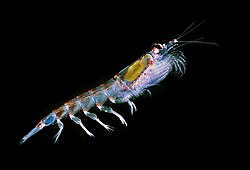Sei whale
The sei whale (Balaenoptera borealis) is a dark-gray, stream-lined baleen whale that is found worldwide except in polar waters. It swims in small pods of 3-5 whales but larger groups may form at rich feeding grounds. It has very fine grey-black baleen that traps very small particles of food. It is a rorqual whale (a large baleen whale) that is similar to the Bryde's whales.
| Sei whale[1] | |
|---|---|

| |
| Sei whale mother and calf | |

| |
| Size compared to an average human | |
| Conservation status | |
| Scientific classification | |
| Unrecognized taxon (fix): | Balaenopteroidea |
| Family: | Balaenopteridae |
| Genus: | Balaenoptera |
| Species: | B. borealis
|
| Binomial name | |
| Balaenoptera borealis Lesson, 1828
| |
| Subspecies | |
| |

| |
| Sei whale range | |
| Synonyms | |
Description
The Sei whale is also called the Sardine whale, the Pollack whale, the Coalfish whale, the Japan Finner, and Rudolphi's rorqual. Large numbers of these whales were hunted until recently for their oil and meat. It is the fastest of the great whales and can swim at about 23 mph (20 knots) in short bursts.
Diet
Sei whales are carnivores that filter-feed plankton (tiny crustaceans like krill, copepods, etc.) and small fish from the water.
Sei Whale Media
Krill, shrimp-like marine invertebrate animals, are one of the sei whale's primary foods.
References
- ↑ Mead, J.G.; Brownell, R. L. Jr. (2005). "Order Cetacea". In Wilson, D.E.; Reeder, D.M (eds.). Mammal Species of the World: A Taxonomic and Geographic Reference (3rd ed.). Johns Hopkins University Press. pp. 723–743. ISBN 978-0-8018-8221-0. OCLC 62265494.
- ↑ Reilly, S.B.; Bannister, J.L.; Best, P.B.; Brown, M.; Brownell Jr., R.L.; Butterworth, D.S.; Clapham, P.J.; Cooke, J.; Donovan, G.P.; Urbán, J.; et al. (2008). "Balaenoptera borealis". IUCN Red List of Threatened Species. IUCN. 2008: e.T2475A9445100. doi:10.2305/IUCN.UK.2008.RLTS.T2475A9445100.en.
- ↑ https://ecos.fws.gov/ecp0/profile/speciesProfile?sId=4753








